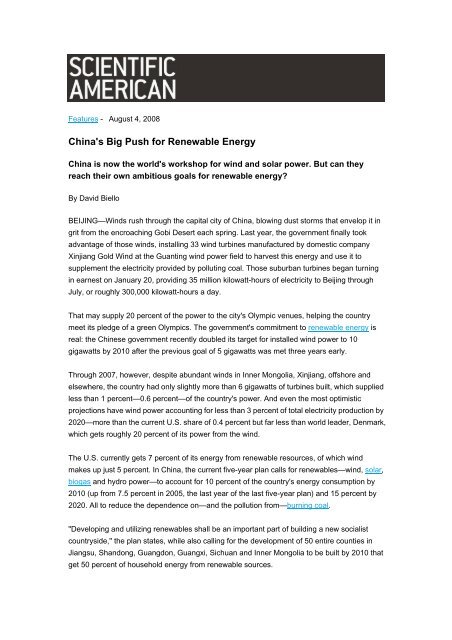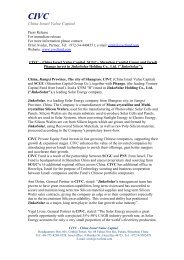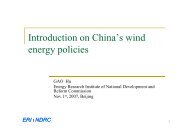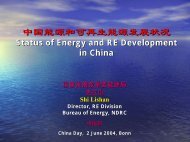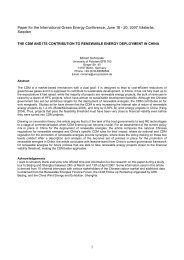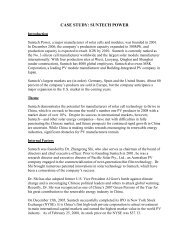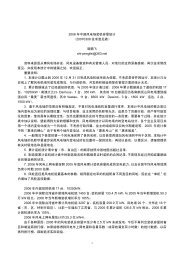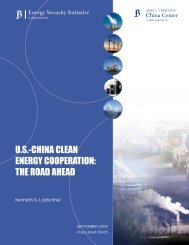China's Big Push for Renewable Energy
China's Big Push for Renewable Energy
China's Big Push for Renewable Energy
You also want an ePaper? Increase the reach of your titles
YUMPU automatically turns print PDFs into web optimized ePapers that Google loves.
Features - August 4, 2008<br />
<strong>China's</strong> <strong>Big</strong> <strong>Push</strong> <strong>for</strong> <strong>Renewable</strong> <strong>Energy</strong><br />
China is now the world's workshop <strong>for</strong> wind and solar power. But can they<br />
reach their own ambitious goals <strong>for</strong> renewable energy?<br />
By David Biello<br />
BEIJING—Winds rush through the capital city of China, blowing dust storms that envelop it in<br />
grit from the encroaching Gobi Desert each spring. Last year, the government finally took<br />
advantage of those winds, installing 33 wind turbines manufactured by domestic company<br />
Xinjiang Gold Wind at the Guanting wind power field to harvest this energy and use it to<br />
supplement the electricity provided by polluting coal. Those suburban turbines began turning<br />
in earnest on January 20, providing 35 million kilowatt-hours of electricity to Beijing through<br />
July, or roughly 300,000 kilowatt-hours a day.<br />
That may supply 20 percent of the power to the city's Olympic venues, helping the country<br />
meet its pledge of a green Olympics. The government's commitment to renewable energy is<br />
real: the Chinese government recently doubled its target <strong>for</strong> installed wind power to 10<br />
gigawatts by 2010 after the previous goal of 5 gigawatts was met three years early.<br />
Through 2007, however, despite abundant winds in Inner Mongolia, Xinjiang, offshore and<br />
elsewhere, the country had only slightly more than 6 gigawatts of turbines built, which supplied<br />
less than 1 percent—0.6 percent—of the country's power. And even the most optimistic<br />
projections have wind power accounting <strong>for</strong> less than 3 percent of total electricity production by<br />
2020—more than the current U.S. share of 0.4 percent but far less than world leader, Denmark,<br />
which gets roughly 20 percent of its power from the wind.<br />
The U.S. currently gets 7 percent of its energy from renewable resources, of which wind<br />
makes up just 5 percent. In China, the current five-year plan calls <strong>for</strong> renewables—wind, solar,<br />
biogas and hydro power—to account <strong>for</strong> 10 percent of the country's energy consumption by<br />
2010 (up from 7.5 percent in 2005, the last year of the last five-year plan) and 15 percent by<br />
2020. All to reduce the dependence on—and the pollution from—burning coal.<br />
"Developing and utilizing renewables shall be an important part of building a new socialist<br />
countryside," the plan states, while also calling <strong>for</strong> the development of 50 entire counties in<br />
Jiangsu, Shandong, Guangdon, Guangxi, Sichuan and Inner Mongolia to be built by 2010 that<br />
get 50 percent of household energy from renewable sources.
"China is already one of the top renewable energy producers in the world," says climate and<br />
energy campaigner Liu Shuang of environmental group Greenpeace. "<strong>Renewable</strong> energy can<br />
provide 50 percent of the energy needs in China," she adds, and the environmental group<br />
projects that 37 percent of that renewable energy could come from wind and solar power alone.<br />
But the reality is that, like the wind, renewable power in China is a fickle source.<br />
There are 158 wind farms in China, according to the Chinese Wind <strong>Energy</strong> Association<br />
(CWEA), and the National Development and Re<strong>for</strong>m Commission (NDRC)—the government<br />
ministry charged with economic development—has called <strong>for</strong> the installation of 10<br />
gigawatts—up from 6 gigawatts at present—by 2010.<br />
Major companies—electricity giant Huaneng Group and state-directed China National<br />
Offshore Oil Corporation (CNOOC)—have responded to the government's goals, looking to<br />
build utility-scale wind farms throughout the country, according to engineer He Dexin,<br />
president of CWEA. "All the good wind farm locations are now owned by the biggest energy<br />
companies," says Greenpeace spokeswoman Sarah Liang.<br />
But even all those good locations will not be enough. "Because land is very precious in China,<br />
some places will not be allowed to build wind farms," notes Dexin, who has been involved in<br />
wind power since the 1970s.<br />
Offshore wind farms may fill the gaps, providing up to 750 gigawatts of electricity, according to<br />
the China Meteorology Research Institute, without impacting farms or other sensitive lands.<br />
"China has the largest wind resources in the world and three-quarters of them are offshore,"<br />
says Barbara Finamore, director of the Natural Resources Defense Council's Beijing office.<br />
Typhoons wreaked havoc on poorly designed wind farms in the south of the country in recent<br />
years, however, and that does not bode well <strong>for</strong> <strong>China's</strong> ability to build in deep waters. "The<br />
reality in China is they develop [wind farms] too fast," says CWEA's Cai Fengbo. "The quality<br />
of wind generation suffered."<br />
Regardless, China remains among the world leaders in building wind turbines, or at least their<br />
components. Even when <strong>for</strong>eign companies such as General Electric or Suzlon supply the<br />
turbines as much as 70 percent of the components are made in China, everything except <strong>for</strong><br />
bearings and electrical controls.<br />
China is also the number one producer of solar photovoltaics, with more than 200<br />
manufacturers creating 1700 megawatts of the panels in 2007, says the Chinese <strong>Renewable</strong><br />
<strong>Energy</strong> Industries Association (CREIA), or nearly half of the world's total production of 3,800<br />
megawatts.<br />
Almost none of that remained in the country, however. "99 percent goes outside," says CREIA<br />
secretary general Li Junfeng. "The local market is very limited because [PV] is too expensive."
Around 80 megawatts of solar photovoltaics are used in the country, cropping up on light poles<br />
in cities like Rizhao in Shandong province or even the roofs of office buildings that hold solar<br />
technology companies, like Beijing Solar <strong>Energy</strong> Research Institute's headquarters in the<br />
capital city. And China has become the world's leading proponent of solar heating technology,<br />
which provides hot water everywhere from Beijing airport's new Terminal 3 to a village inn in<br />
Yunnan Province, because it is as cheap as the alternatives.<br />
Still, says Greenpeace's Liu, "It's a waste of all the production in China. It doesn't make<br />
sense."<br />
And all of that production means that China is bearing the burden of the pollution that can go<br />
along with the manufacture of such renewable energy <strong>for</strong> other countries—whether the acid<br />
rain–<strong>for</strong>ming sulfur dioxide emitted from making the steel in a wind turbine's blade or the<br />
noxious chemicals left over after manufacturing specialized silicon, or glass, that can turn<br />
sunshine into electricity. "To stop global warming, it's not an excuse to destroy the local<br />
environment," says Greenpeace's Liu. "Producing photovoltaics must have strong controls on<br />
chemicals."<br />
So that leaves dams as the cleanest, cheapest option <strong>for</strong> electricity generation in China.<br />
And the country is blessed with abundant resources in that area: 400 million kilowatts of<br />
potential of which only 110 million kilowatts have been developed, according to government<br />
figures. "Within 30 to 50 years, hydro will be the main energy we should rely on," predicts Lai<br />
Hun Suen, a professor of sustainable development at Chongqing University and a municipal<br />
government official.<br />
Dams accounted <strong>for</strong> 16 percent of total electricity generation in 2005, thanks to the completion<br />
of Da Chao Shan, Gong Bo Xia and Three Gorges dams. But it is a technology that has proven<br />
problematic in developed and developing countries—witness the ecological problems brought<br />
on by the Three Gorges—and most of the undeveloped locations <strong>for</strong> hydropower are located in<br />
the west of the country while the majority of electricity use is in the east.<br />
Nevertheless, "China will try to rely on hydropower," Lai says. "It is a choice we made when we<br />
had no other choice."<br />
http://www.sciam.com/article.cfm?id=chinas-big-push-<strong>for</strong>-renewable-energy&print=true


